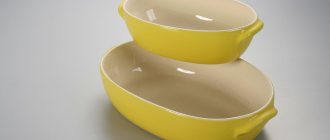Publication in the group: Dishes from cottage cheese, dairy products
To preserve cottage cheese, you often have to resort to methods such as freezing it. Defrosting a product from the freezer is simple and quick, but its properties change somewhat. These features must be taken into account, since the thawed product is not suitable for all dishes.
Is it worth freezing cottage cheese?
If you need to freeze cottage cheese, it is best to buy a full-fat product if possible. This is because it freezes much better than low-fat varieties. It's also important to remember that store-bought packaging can be a little flimsy, so it's a good idea to place it in a freezer bag if possible.
The easiest way is to put the product in store-bought plastic or polyethylene packaging in a ziplock bag, release all excess air and close it tightly. Once this is done, be sure to mark the bag with the date it was frozen and place it in the freezer. In this form it can be stored for up to 6 months (however, the sooner it is consumed, the better).
The disadvantage of freezing cottage cheese in store-bought packaging is the need to use it entirely after defrosting, even if the volume of the product is quite significant. Therefore, some housewives prefer to place the product in smaller, hermetically sealed containers or bags. This allows you to freeze smaller quantities, which will thaw faster.
Using zip bags is preferable to containers in this case as well, as they can lie flat and take up less space. In addition, the defrosting process is easier in them.
In any case, it is important to remove all air from the packaging as this prevents ice crystals from forming inside. To prevent icing, you can also wrap each bag twice, then place them inside the freezer and stack them on top of each other. When placed directly into ziplock bags or containers, the cottage cheese will keep in the freezer for up to 3 months.
Which curd products are best not to freeze?
Cottage cheese perfectly retains its nutritional value when frozen, the expert says, but curd products that contain large amounts of sugar or its substitutes, preservatives, stabilizers, synthetic flavors and emulsifiers cannot be frozen. “If we are talking about cottage cheese, then it can be of a plastic consistency or grainy. It is advisable not to freeze everything else - pastes, curd masses and other curd products. After defrosting, they lose their properties, consistency and structure,” says Yurova.
Article on the topic
Seize the moment. How to properly prepare cottage cheese at home
Rules for defrosting cottage cheese
There are several ways to defrost cottage cheese from the freezer, but the safest of them is not done too quickly. To do this, you need to put it in the refrigerator overnight or for several hours.
It is strongly not recommended to leave it to thaw at room temperature because this may encourage bacterial growth.
Rules:
- When the product is completely defrosted, you need to remove excess liquid from it by draining it, then stir it to restore at least approximately the original texture.
- If the product has become too liquid, it can be thickened by adding 1 tsp. corn starch.
- To make the product more creamy, it is recommended to add a little sour cream to it after defrosting (1 teaspoon per glass).
- Thawed cottage cheese is good for only 3-4 days and cannot be re-frozen. Therefore, it is necessary to decide on its use before it is removed from the freezer.
After freezing, cottage cheese becomes crumbly because it loses some of its moisture, so it is only suitable for recipes that require cooking. Defrosting slowly helps retain any remaining liquid to ensure an even texture.
This process works like this:
- You should remove the cottage cheese from the freezer the day before you need it (or at least 12 hours before using it). When defrosting a portioned product, you need to transfer it from a zip bag or container to another container with a lid.
- Then you need to move the curd to the refrigerator and maintain the temperature between 2 and 4°C while thawing (this can be achieved on the bottom shelf). Defrosting slowly while cooling prevents the product from drying out, which improves its texture. Temperatures below 4°C also protect the cottage cheese from the growth of pathogenic bacteria.
- The condition of the product should be checked after approximately 6 hours, or when it has partially thawed.
- The defrosted layer can be removed and used for cooking, and the remaining part must be left until completely defrosted. This may take up to 24 hours.
Shelf life in the freezer and refrigerated
The shelf life of frozen cottage cheese, if all rules are followed, can reach 8-9 weeks. Considering that fresh fermented milk product is stored for no more than a week, this is a very good alternative. It must be said that it is not so important whether fresh cottage cheese will be used to prepare a delicious breakfast or frozen raw materials.
In any case, cottage cheese should be eaten whenever possible, as it helps the human body to be healthy.
To learn how to freeze dairy products, see the following video.
Quick defrosting methods
You can quickly defrost cottage cheese from the freezer only if you plan to use it immediately. All these methods may be unsafe.
| Fast defrosting method | Time needed | Peculiarities |
| At room temperature | 2-3 hours | The product may spoil, especially if the room is hot. |
| In cold water | 3-6 hours | Suitable mainly for small bags or containers of cottage cheese. |
| In hot water | 1-1.5 hours | The product may not be heated evenly and its texture will become thinner. |
| In the microwave | up to 10 min. | Cottage cheese can only be defrosted at minimum microwave power. |
| In the oven | 30 min. | Only permissible at temperatures around 30°C. |
| In a slow cooker | 10-30 min. | The product may absorb liquid from the steam and become watery. |
At room temperature
This method is used when the product will be subjected to immediate heat treatment. To quickly defrost cottage cheese, you need to remove it from the freezer and leave it indoors for 2-3 hours in a sealed zip bag or container.
After the specified time has passed, you need to drain all the liquid from it and start cooking.
In cold water
To speed up the process of defrosting cottage cheese, you can place the container or bag of frozen product in cold or warm water. This way it will thaw within a few hours, depending on the serving size and packaging (bags defrost faster).
In the microwave
You can quickly defrost cottage cheese from the freezer in the microwave. To do this, you will need to use the lowest power of the electrical appliance in the defrosting mode (or using the option for bread or seafood, depending on the model and functionality).
The basic rule when defrosting cottage cheese in the microwave is that it should remain cold during the process. To do this, heat it at the specified mode in sessions of 1-1.5 minutes, after which take breaks of 30 seconds. and turn it over every time. A product packaged in a bag will defrost faster compared to a container.
In the oven
Thawing the product in the oven at high temperatures is not recommended in the same way as in hot water. However, some modern models of kitchen equipment have special modes that allow slow, smooth heating. In this case, you will need to preheat the oven to 30°C and turn on convection, then place the cottage cheese in it for 10 minutes. Halfway through this time, it is recommended to turn the product packaging over.
In a slow cooker
You can quickly defrost cottage cheese from the freezer in a slow cooker. To do this, you will need to place the packaged product on the grill and turn on the electrical appliance in steamer mode. In this case, it is necessary not to close the lid and turn the product over from time to time. This will ensure even defrosting and prevent excess moisture.
In hot water
When the package is placed in a container with hot water, the outer layer of cottage cheese will quickly thaw, but the inside will remain frozen. Its quality will be noticeably deteriorated - it will become liquid and inhomogeneous.
How to quickly defrost cottage cheese - this can be done in hot water.
Therefore, this method can only be used for defrosting small packages and only when absolutely necessary.
How to store without refrigeration
It is very difficult to store dairy products without refrigeration. If you can extend the shelf life of milk by boiling, and butter by wrapping it in parchment soaked in salted water, then these methods do not work with cottage cheese.
Still, there are ways in which, if absolutely necessary, you can extend the viability of this product:
- Place the cottage cheese in a clean and dry glass jar, compacting it as tightly as possible so that air does not penetrate. Cover the container with gauze soaked in salt water. Place in a cool place, protected from light.
- In the past, this method was also used: homemade cottage cheese was placed in an enamel pan or a special barrel. The walls of the container were pre-treated with hot steam, and the bottom was sprinkled with table salt. The top of the product was covered with a cloth soaked in saline solution and closed with a lid on which oppression was placed.
However, even at a temperature lower than room temperature, pathogenic bacteria begin to grow in the cottage cheese, while lactic acid bacteria are inhibited, which leads to spoilage of the product.
Buy the product in quantities in which you can use it for food or for making dishes within the next 24 hours.
Using cottage cheese after freezing
Thawed cottage cheese is only suitable for heat-treated dishes.
There are quite a few options, including:
- cheesecakes and similar desserts;
- casseroles and pasta;
- syrniki.
One of the best recipes for using it is preparing pasta dishes (all kinds of pasta and lasagna). It is also recommended to add it to dough, including for muffins and pies. Other dishes that you can add defrosted cottage cheese to include omelettes, sauces, and even mashed potatoes. In many cases, you can add frozen cottage cheese to a dish during cooking without defrosting it first.
You just need to immerse the container with it in cold water for a few seconds. This is necessary so that the surface of the cottage cheese can thaw a little, and it is easier to remove it from the container. After this, you should add it to the prepared dish.
It should be noted that in this case you will need to add a little extra cooking time, since the frozen product will cool the remaining components. It is recommended to stir the ingredients so that the dish is cooked evenly and the cottage cheese is completely defrosted.
If you plan to use the cottage cheese yourself, it is important to drain off excess moisture. This is because the curd will be a little watery and this will not work. You can add a little more cream if it is too dry.
Culinary products such as pancakes and pies with cottage cheese can only be defrosted in the refrigerator, placing them there several hours before cooking. Cheese pancakes and cottage cheese pancakes can be frozen raw and then cooked without prior defrosting.
An example of using cottage cheese after freezing
Using cottage cheese instead of some high-fat cheeses in pasta recipes allows you to create delicious diet dishes. In this case, you can use a previously frozen product.
To prepare curd sauce for pasta, you will need:
- 1 tbsp. milk;
- 0.5 tbsp. cottage cheese;
- 1 tbsp. l. corn starch;
- 0.25 tsp salt;
- 1/8 tsp. coarsely ground pepper;
- 0.25 tsp garlic powder;
- 0.5 tbsp. grated parmesan cheese;
- dried basil;
- dried oregano;
- fresh chopped parsley.
The cooking process is carried out as follows:
- Blend all ingredients except basil, oregano and parsley in a food processor until smooth.
- The resulting mass should be poured into a small saucepan, then add dried herbs, heat over moderate heat until creamy, stirring.
- You need to add salt, coarsely ground pepper and other spices to taste into a homogeneous sauce, and cook over low heat for 5 minutes, always stirring several times.
- A few minutes before serving, add the cooked pasta to the sauce and stir to absorb the flavor, and serve with chopped parsley.
Useful tips
Cottage cheese often retains many of its nutrients and health benefits after being frozen, so the freezer is a great place to store it for long periods of time.
Adviсe:
- If defrosted cottage cheese turns yellow, becomes excessively watery and/or acquires a sour smell, it can no longer be eaten.
- If, after defrosting, the product has released a lot of liquid and becomes dry, its consistency can be restored by adding a little sour cream or thick cream.
- If a large package of the product is thawed, it can be squeezed, pressed and slightly dried to obtain homemade soft cheese.
If you need to defrost cottage cheese from the freezer quickly, you should not expose it to too high a temperature. The thawing process should in any case be gradual.
How long can cottage cheese be stored in the freezer?
The duration of storage of cottage cheese depends on whether additional ingredients were used when preparing it. All useful information is collected in the table:
| Storage method | Best before date |
| Ordinary fresh cottage cheese at a temperature of −18 degrees Celsius | 6 months |
| Curd mass with eggs | 2 months |
| Curd mass without eggs | 4 months |
| Thawed cottage cheese | 2 days |











